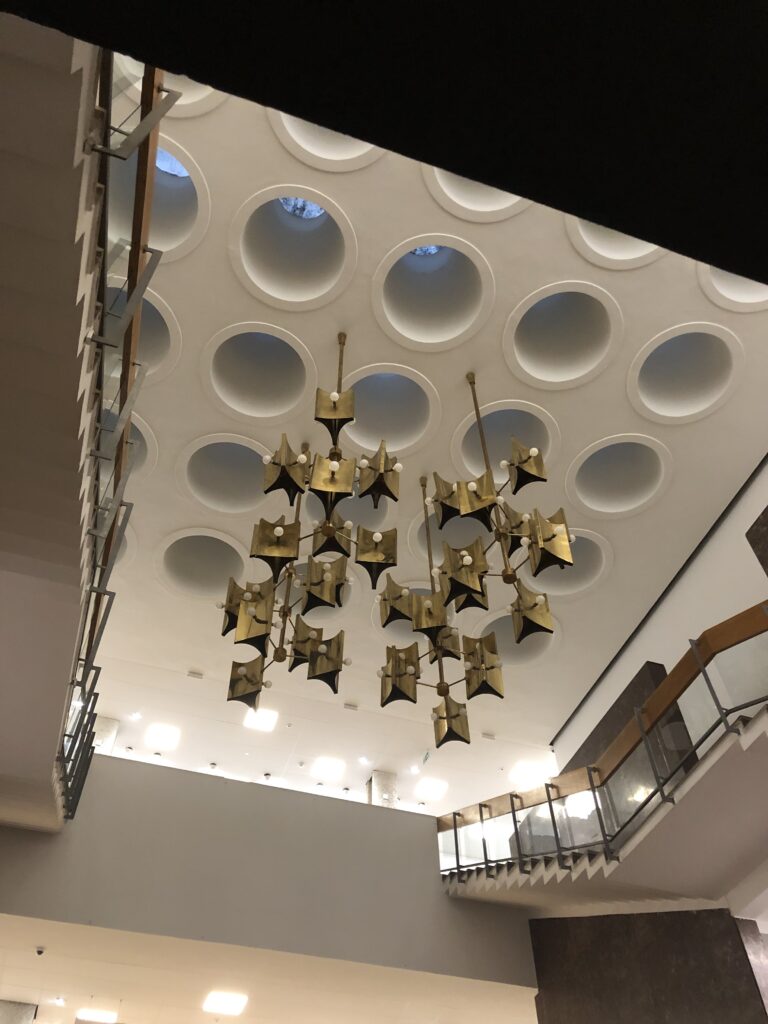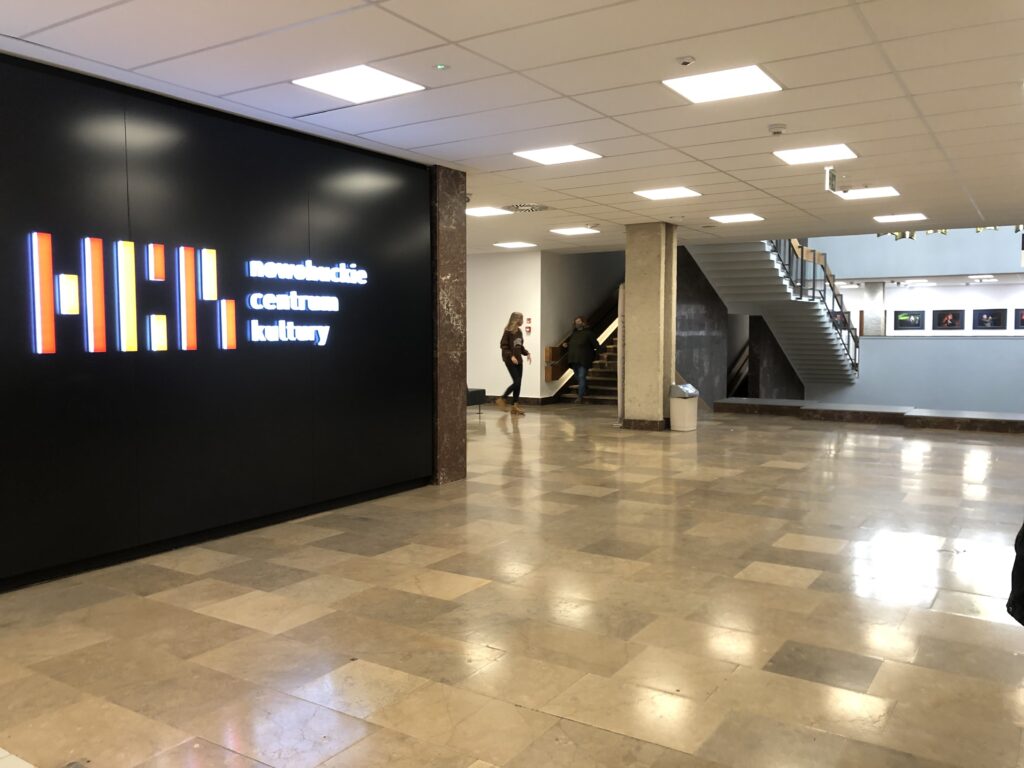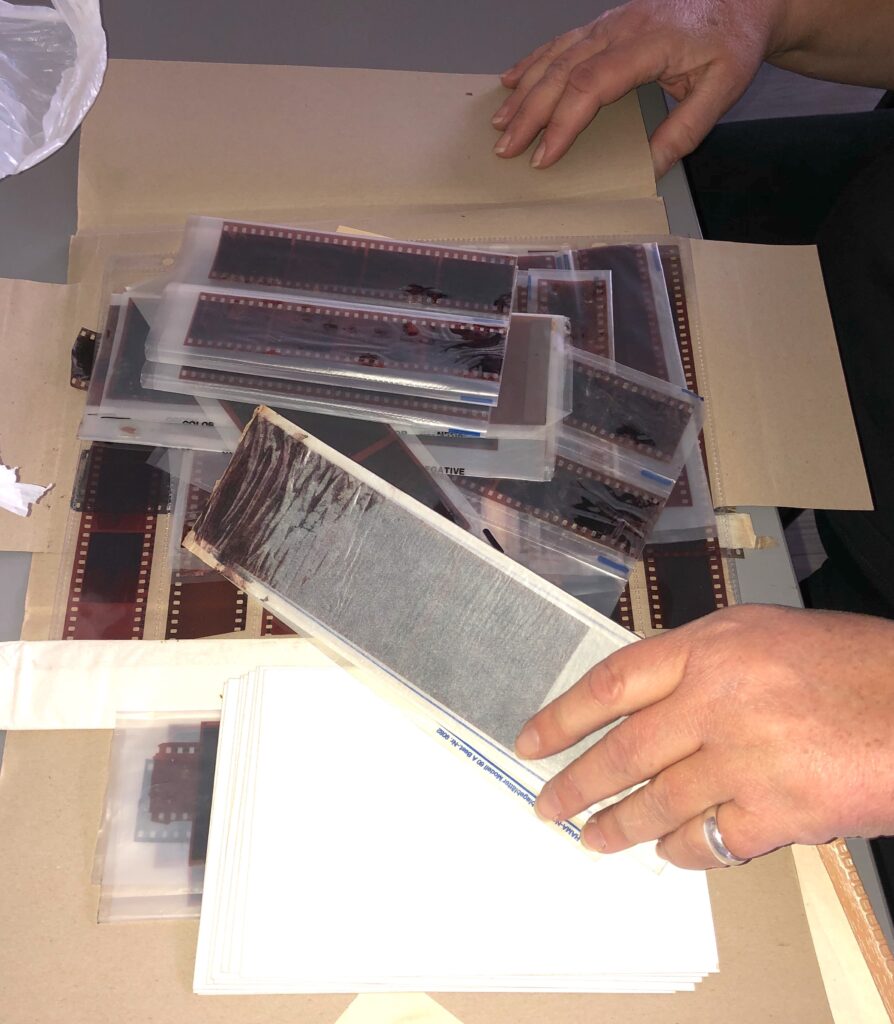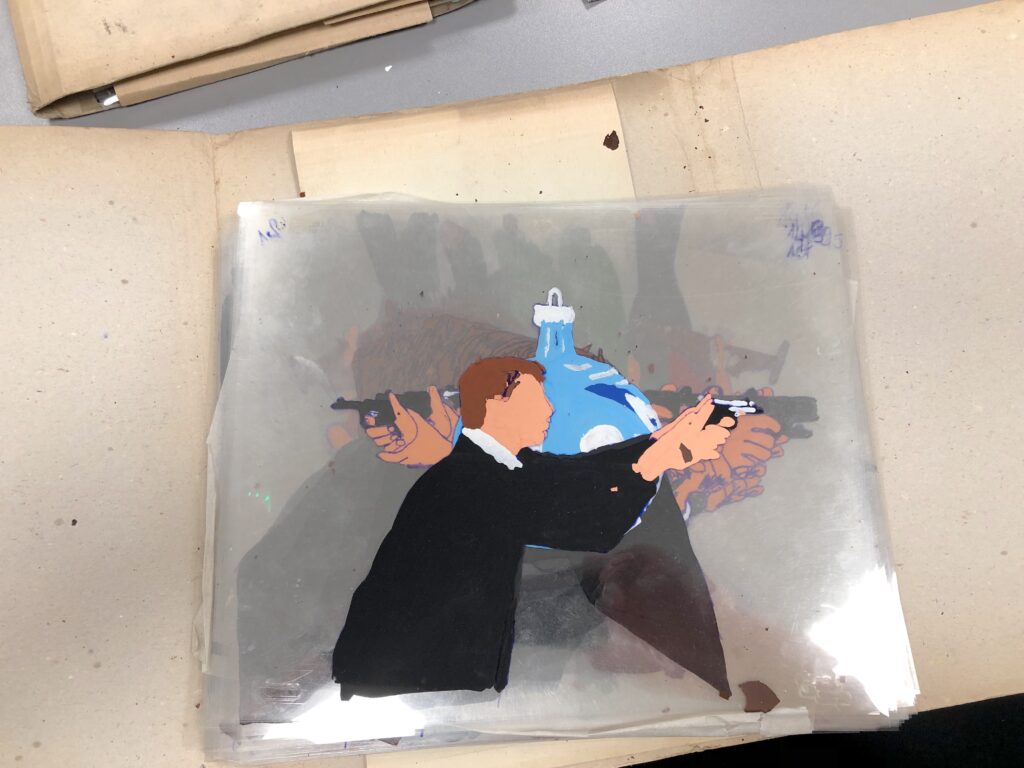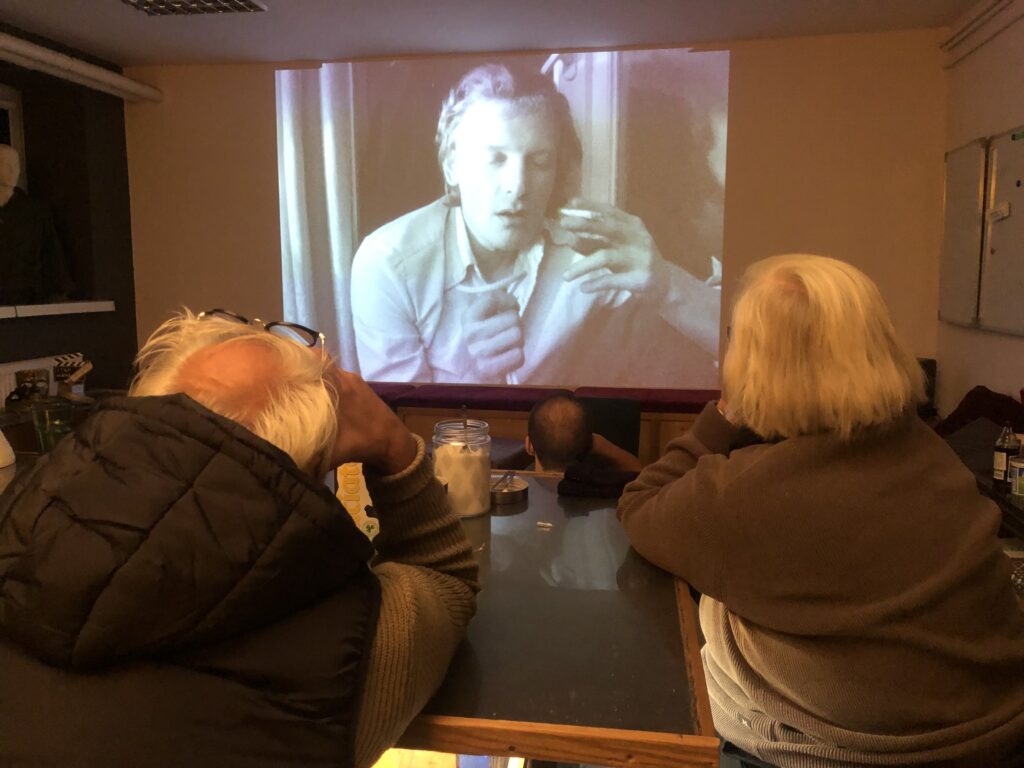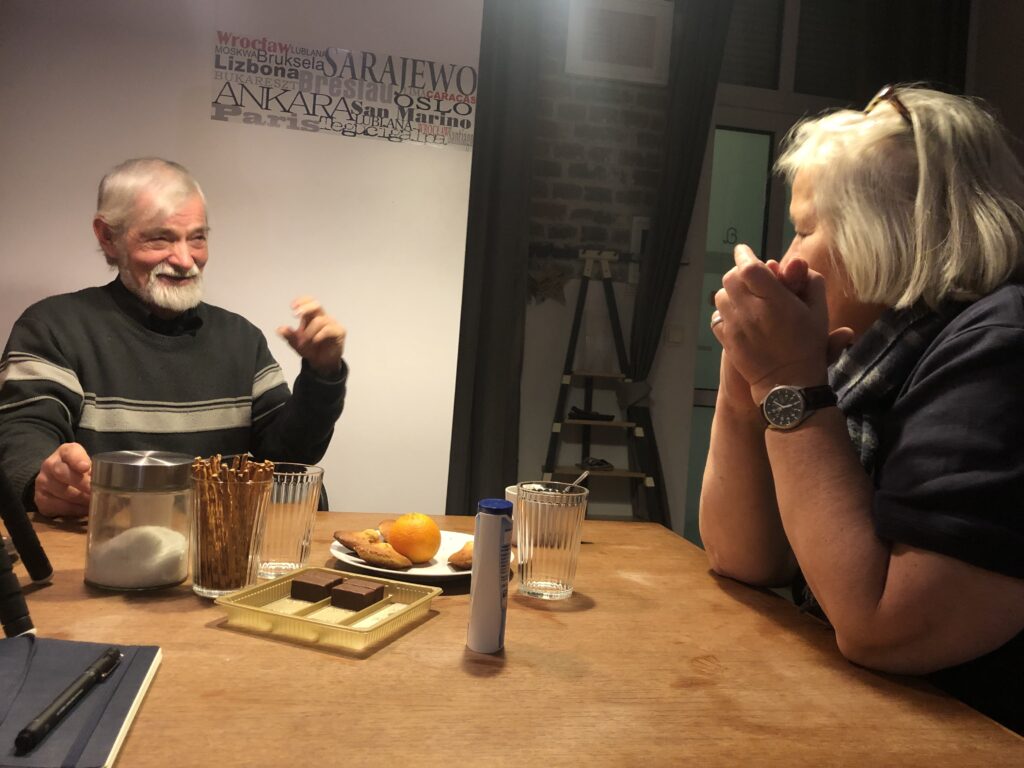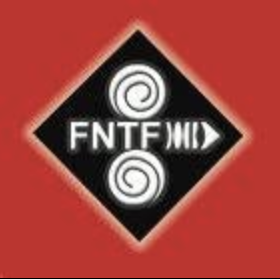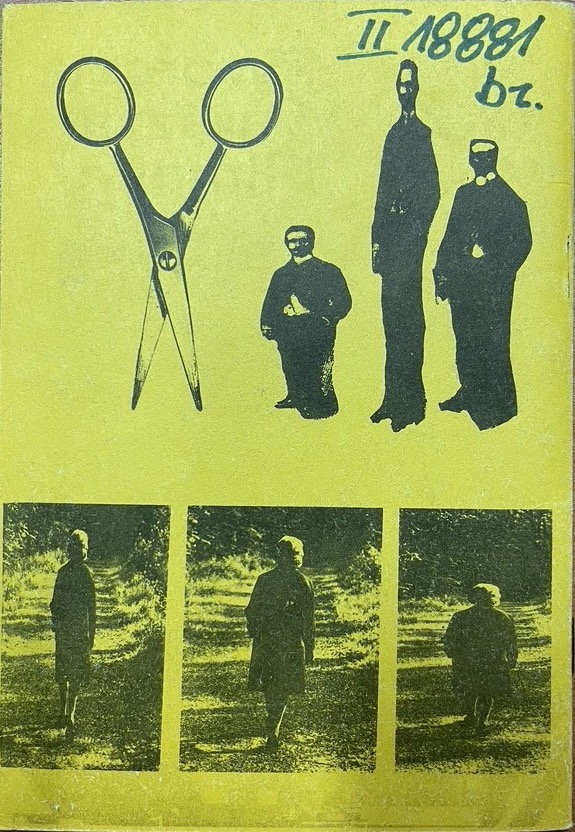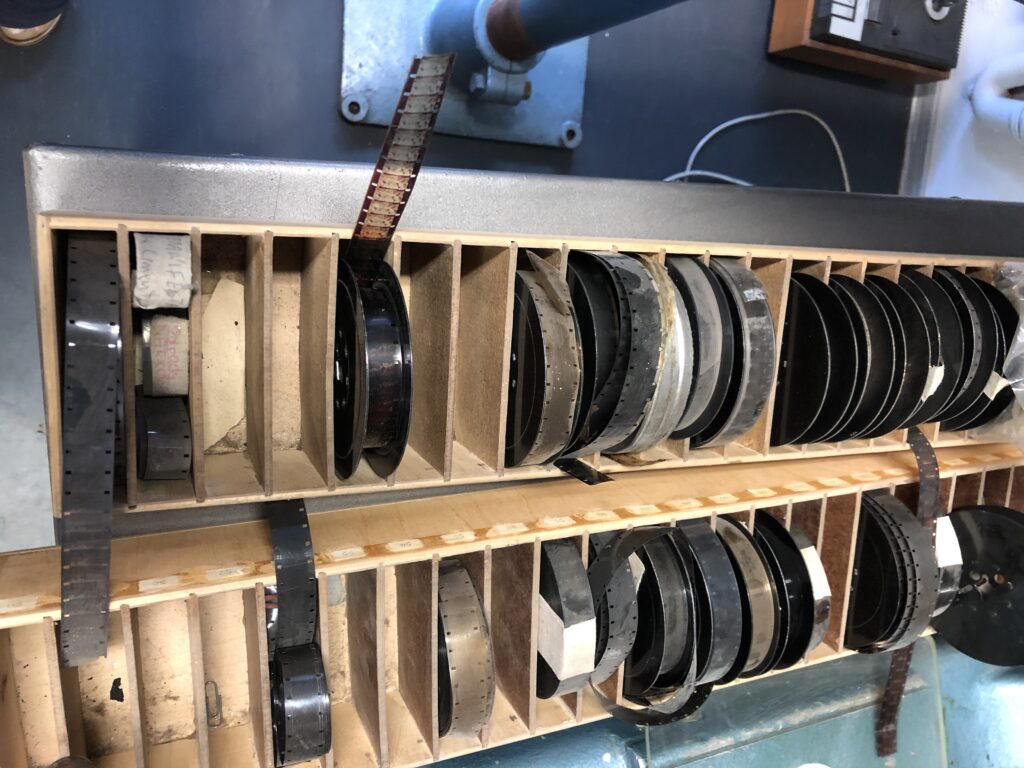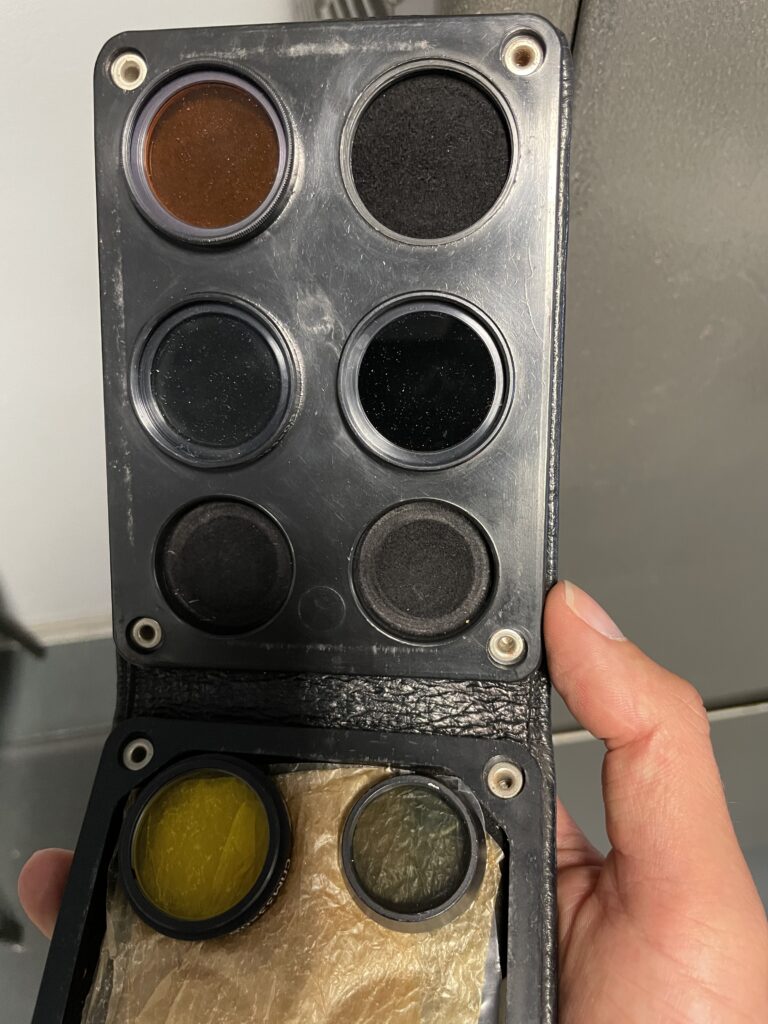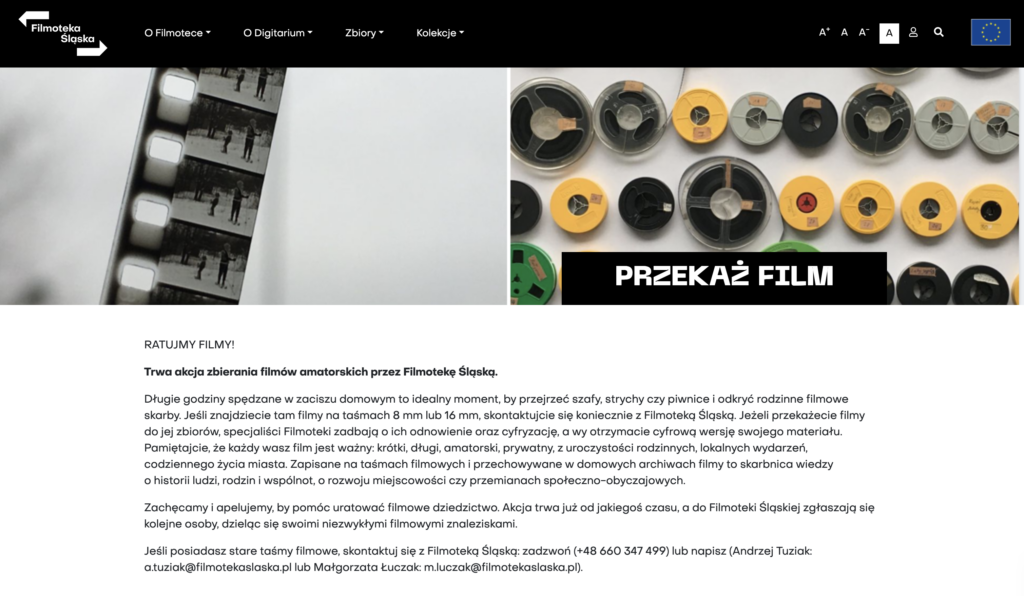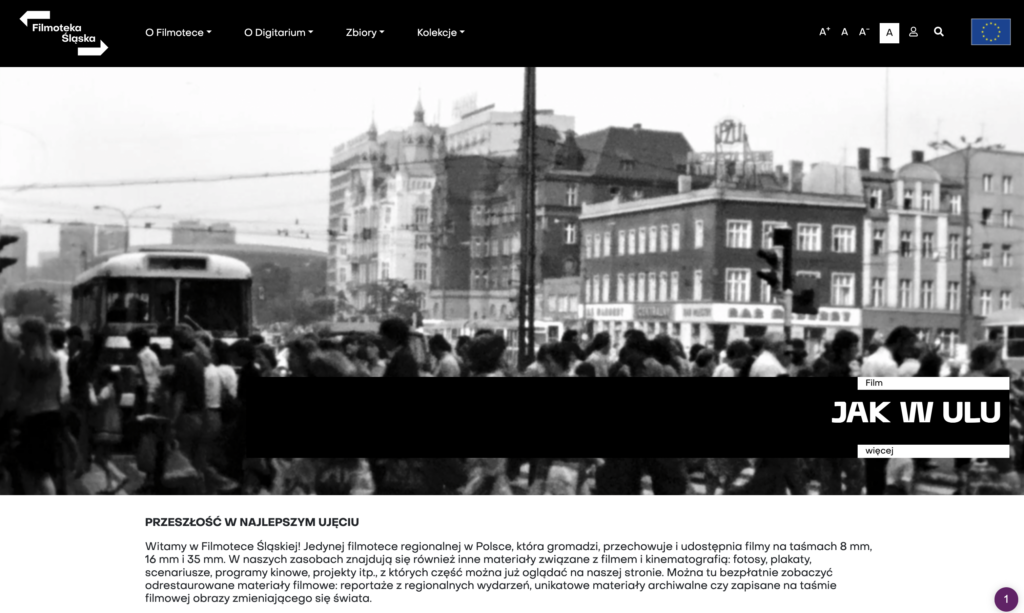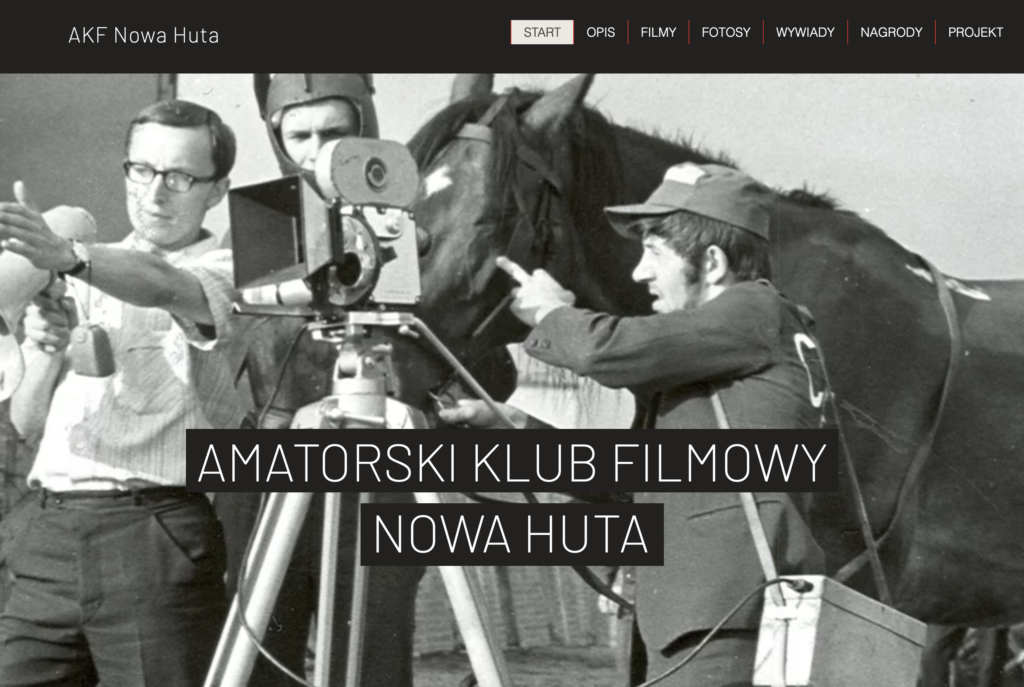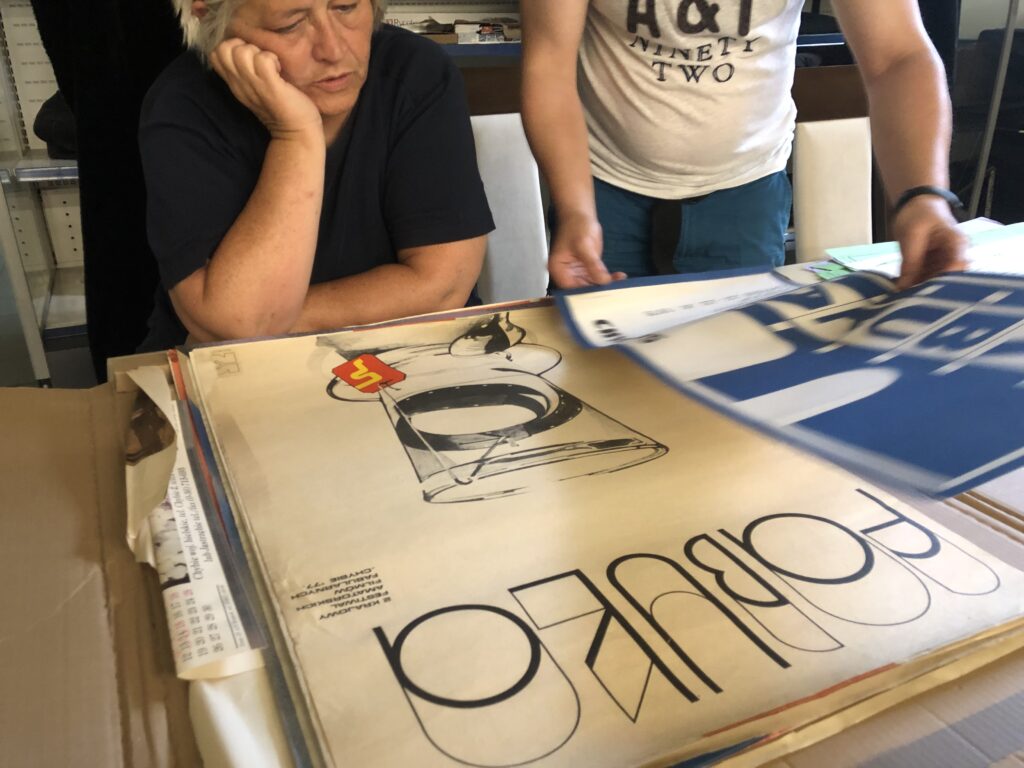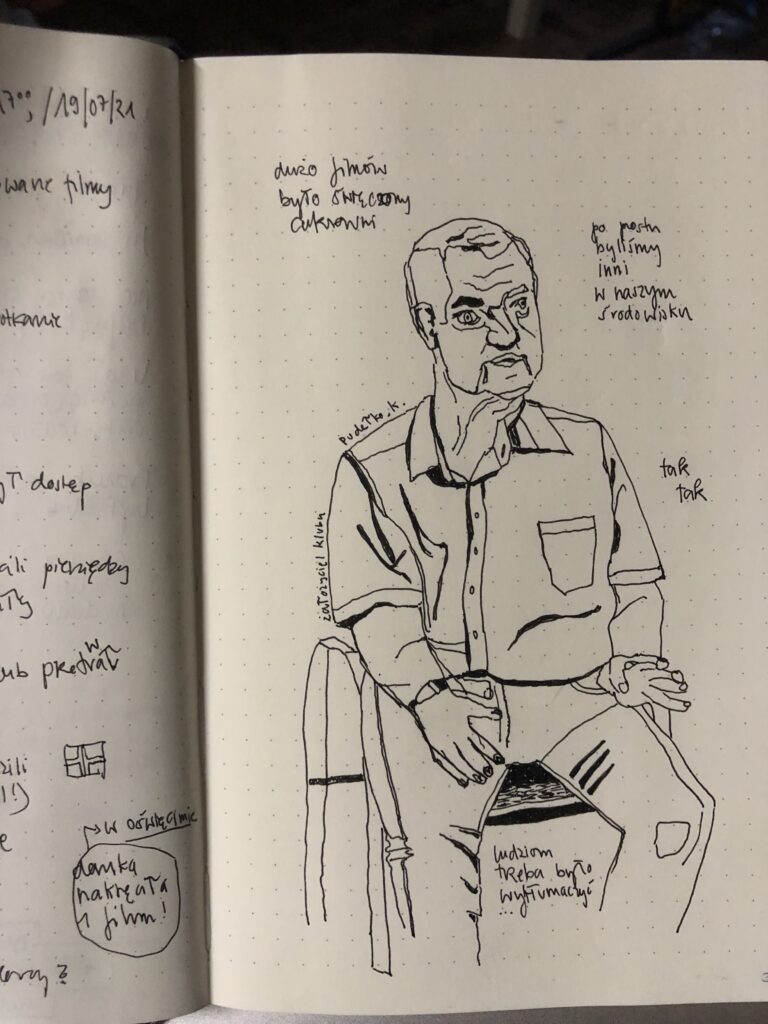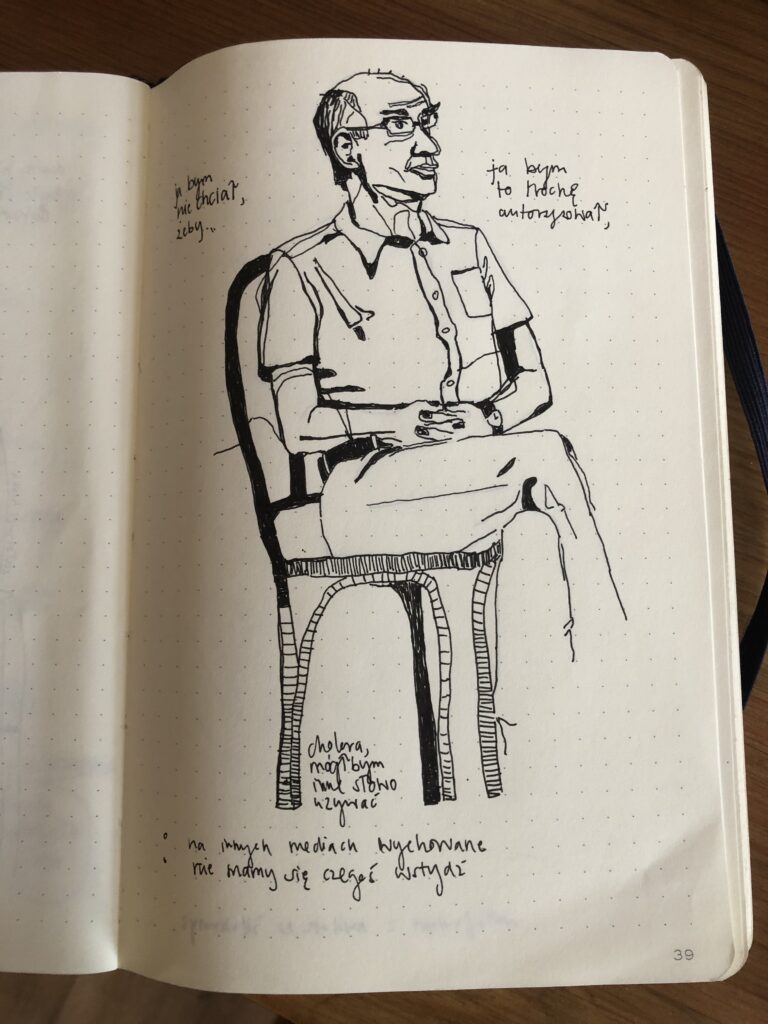From the Project | Research journey
Kraków 2:
Nowohuckie Centrum Kultury:
Impressive in both its exterior and interior architecture, the Nowohuckie Centrum Kultury/ Cultural Center Nowa Huta building is located in the Kraków district of the same name. Nowa Huta is still characterized by its architectural heritage as a communist planned city, comparable, for example, with the German Eisenhüttenstadt. Built in the Stalin era around the country’s largest ironworks combine – Huta im. Lenina/ Lenin Steelworks – built by 1954, as a new workers* center near Catholic-conservative Kraków, which rejected the new system. Designed in the style of Socialist Classicism, the planned city was the object of a major propaganda campaign to symbolize the huge combine as a success of the planned economy and the result of unwavering friendship with the Soviet Union. However, the layout of the city, with five main avenues radiating from a central square, evoked analogies of the Stalinist building style with the lavish representation of absolutism and was intended to eclipse the old royal city of Kraków. Ideologically, this was supposed to create an axis of conflict between the intellectual Kraków and the working class people of Nowa Huta.
In the Department of Photography and Film of the Nowohuckie Centrum Kultury (short: NCK) lies the archive of the AKF “Nowa Huta”. For more than two decades the amateur film club had its workplace in Zakładowy Dom Kultury Huty im. Lenina (in short: ZDK HiL)/ Plant Culture House of Lenin Steelworks; since 1990 renamed to Dom Kultury im. Cypriana Norwida/ Culture House of Cyprian Norwid. Located in Klub Młodych/ Youth Club in Osiedle Młodości/ Settlement of Youth, where he shared the working premises with Amatorski Klub Fotografików/ Photoamateurs Club. For a short period of time it was temporarily located in ZDK HiL in Mayakowski Street, until the two clubs were merged into one department and their headquarters were moved to the new NCK in 1983.
While the AKF “Nowa Huta” no longer exists, the two photography instructors Adam Gryczyński and Anna Bobula still work in the Department of Photography and Film of the NCK, where the archive is also kept. Margarete Wach, together with Cäcilia Wosnitzka (WBH), was able to spend several days doing extensive research in the AKF “Nowa Huta” archive, which included several dozen photographs, film negatives, drafts and completed scripts for animated films, over 100 film prints, festival documentation, course books, club chronicles, diplomas and awards, membership lists, and so on.
AKF Nowa Huta” was founded in the fall of 1958 by the photographers Witold Michalik and Władysław Wolak. In the thirty years of its existence, the club acquired a high reputation and established itself as one of the most important amateur film clubs in the country. Between 1958-1990, a total of 200 films were made, which received 94 prizes and awards in national and 11 in international competitions and festivals, including a silver medal in the UNICA (World Association of Film Amateurs) competition for “Zielone słońce” (Green Sun, 1973) by Jerzy Ridan and two bronze medals for “Niezastrzeżone prawa” (Unreserved Rights, 1960) by Jerzy Kaszycki, Krzysztof Konarzewski and Ryszard Zawidowski and “Wspomnienie” (Remembrance, 1965) by Krzysztof Kwinta and Maciej Korus. Among the amateur film clubs, which like AKF “Muza” (Konin), AKF’s “Groteska” and “Alchemik” (Kędzierzyn-Koźle) or AKF “Chemik” (Oświęcim) operated in the environment of large industrial combines, from which they were alimented, Nowa Huta managed to develop a wide range of film genres in addition to the obligatory exercises associated with them: Feature films, documentaries, animated and experimental films in the mode of artistic auteur films. In addition, the club managed to attract many talented film enthusiasts, who made their first films here and then went on to professionalize themselves through study or TV work.
AKF “Nowa Huta” quickly had become a forge for the personnel cadres of Polish film and public television. The first films of: Krzysztof Zanussi, Andrzej Trzos-Rastawiecki, Artur Janicki, Jerzy Ridan, Wincenty Ronisz, Krzysztof Kwinta, Grzegorz Kwinta, Tomasz Dettloff, Krzysztof Konarzewski, Ryszard Zawidowski, Maciej Braunstein, Adam Głąbiński, Tadeusz Metz.
Due to the spatial fusion of photography and film, club members benefited from the cooperation of the two clubs. As a photography instructor, Adam Gryczyński also made important and award-winning films in AKF “Nowa Huta” and was responsible for the organization of the Polish Amateur Film Competition OKFA by the club in 1987. AKF “Nowa Huta” temporarily had two instructors: Alicja Zawadzka as artistic supervisor and Krzysztof Szafraniec as technical supervisor. Until the closure of the club in the transition year of 1990, Marek Norek still fulfilled this function. A unique feature of AKF “Nowa Huta” was its screenplay competition for film amateurs from all over Poland, which made it possible to fund interesting projects with three graduated cash prizes.
In the NCK archive of AKF “Nowa Huta” there are also three cabinets with dozens of film prints, which are inventoried alphabetically in a catalog. Unfortunately, only 25 of them have been digitized so far, so it would take several weeks of sighting to have seen them all.
During her visit in early December 2021, Dr. Wach was able to hold several conversations with Adam Gryczyński and learned of two other contemporary witnesses who still needed to be interviewed: Alicja Zawadzka, who emigrated to Paris in the 1980s, and Lucyna Lubańska. The interviews with them will still be made up via Skype, especially since they can also contribute a female perspective on the film amateur movement.
Bielsko-Biała:
Dom Kultury Włókniarzy: In the south of Poland, not far from the Czech and Slovak borders, lies Bielsko-Biała, once an important industrial center, known mainly for its textile industry, but also home to a car (Fiat 126p) and glider factory and mechanical engineering. Since 1947, the city’s landmark has been the Studio Filmów Rysunkowych Bielsko-Biała/ Studio for Animated Films Bielsko-Biała, where, among other things, the world hit series “Bolek i Lolek” was created. The Teatr Lalek Banialuka (Puppet Theater Banialuka), which has been organizing an international festival of puppet art since 1966, is also internationally renowned. Since the early 1960s, the Dom Kultury Włókniarzy/ House of Culture of Textile Workers housed the AKF “Bielsko”, one of the most important and productive amateur film clubs in the People’s Republic of Poland.
Among the instructors of the club from the very beginning were Henryk Urbańczyk, Marian Koim and Oktawian Fedak, all of whom are no longer alive. The club had its breakthrough in 1964 at the 12th Polish Amateur Film Competition OKFA in Lublin, when AKF “Bielsko” received the festival’s Grand Prize for its group performance and won the animated film competition with “Romanza ludzika” (The Romance of a Human, 1964) by Jan Habarta and Marian Koim. In the following three decades, mainly documentary and animation films from Bielsko-Biała filled the prize lists of the two most important Polish amateur film festivals “OKFA” (for 16mm) and “POL-8” (for 8mm) and also recorded successes abroad.
Dr. Wach succeeded in locating Krzysztof Korzonkiewicz and conducting an interview with him. Korzonkiewicz produced several important and award-winning animated films with his brother Wiesław Korzonkiewicz, who died at an early age, or on his own in the 1970s and 1980s. Barbara Łoboda of the Puppet Theater Banialuka, who was also an instructor of the club in 1978-1979, realized some films, such as “Panta rei” (1981), together with Henryk Urbańczyk, who was probably the most prolific and most decorated instructor with awards in the history of the club. From the holdings of AKF “Bielsko” in DK Włókniarzy, copies of over 100 films were digitized some time ago and are currently being successively made available to the public on the local portal “„Bielski Almanach“.
Thanks to the willingness of the director of Dom Kultury Włókniarzy, Barbara Jacyków, Margarete Wach, once again accompanied by Filip Jacobson, was able to conduct a broad research over several days in the archives of AKF “Bielsko-Biała”, which still contains about 110 copies of films, hundreds of photos and diplomas for winning prizes, posters, textbooks and course books, as well as detailed documentation on the editions of the “Fazy” Festival. Both sides agreed to establish a cooperation between Dom Kultury Włókniarzy and the University of Siegen in order to be able to use the photos, the lifted archive material and the digitized films of the club for the project homepage and publications.
Throughout the history of the club, there were close contacts between AKF “Bielsko” and the Studio of Animated Film Bielsko-Biała, whose head Adam Hajduk and his staff were invited to the meetings of the courses of animated film. Marian Cholerek from the Studio of Animated Films, who was also a member of the Club, was one of the creative minds behind the Festiwal Amatorskich Filmów Animowanych “Fazy”/ Festival of Animated Films of Amateurs “Phases”, which was organized from 1973 by the Club in cooperation with the Studio. This local proximity and cooperation between the two institutions made it possible for leading Polish animators such as Stanisław Lenartowicz or Mirosław Kijowicz to come to Bielsko-Biała to preside over festival juries or give workshops on animated films. Already in the late 1970s, the festival was also visited by many amateurs specializing in animated film from Western Europe, including the FRG, Switzerland and Austria, as well as from South America, which drew the attention of the State Security, which operationally targeted and monitored the festival.
Dom Kultury in Kozy:
In the late 1970s, the AKF “Bielsko” also marked the beginning of the “career” of Marek Małecki, who found his way to animated films as a teenager and quickly became successful at film festivals with his works such as “Blaga” (humbug) or “Dż, dż, dż …” (1978). He realized his next auteur film “Fotodrama” (1985) as a student of the Łódź Film School under professional conditions in the renowned studio of animated films “Se-Ma-For” in Łódź. After graduation, he was employed at “Se-Ma-For” and, following his own scripts, was able to realize six animations, including “Romanca” (Romance, 1986) and “Straszydełko” (Little Monster/Fright, 1988). From 1988 to 1989 he was one of five directors to realize the 13-part puppet animation series “Maurycy i Hawranek” (Moritz and Hawranek, 1987-1990). When, with the political changes of 1990, the entire cinematography economically and administratively, and thus also the state-subsidized film studios, went off the rails, he returned to Bielsko-Biała, not least for personal reasons.
Today Małecki is the director of the Dom Kultury/ Local House of Culture in Kozy, a small town in the northeast of Bielsko-Biała. Margarete Wach visited him there together with Filip Jacobson and interviewed him about his time at AKF “Bielsko”. Marek Małecki took this as a welcome opportunity to finally announce his amateur credo: Amateur film is his passion, “I don’t take money, so I can do anything” (“jestem pasjonatą, nie biorę pieniędzy, wszystko mogę”).
Oświęcim / AKF “Chemik”: AKF “Chemik” is a classic example of amateur film clubs around large industrial state-controlled plants, similar to AKF “Muza” in Konin, AKFs “Groteska” and “Alchemik” in Kędzierzyn-Koźle or AKF “Nowa Huta” in Kraków. Its seat today is in Oświęcimskie Centrum Kultury OCK/ Kulturzentrum Oświęcim. However, the club was founded in 1963 by Henryk Lehnert, Marian Żmuda and Marian Koim as part of the Zakładowy Dom Kultury “Chemik”/ the plant-owned Cultural House “Chemist”, which was the cultural house of the Zakłady Chemiczne “Oświęcim”/ Chemical Plants in Oświęcim. Accordingly, one of the tasks of the film instructor in the club was the regular production of the so-called Kroniki Zakładowe/ the Plant Chronicles. These cinematic accounts of then-important events or happenings at the plant or in the town dominated by it even established themselves as a cinematic subgenre in the field of industrial film. Henryk Lehnert has produced hundreds of them in his more than 40-year career and, similarly to Józef Szyk of AKF “Muza”, has received awards for them at amateur film festivals specializing in plant chronicles. In addition to artistic images, AKF “Chemik” still produces films documenting events in the city’s history, such as everyday and holiday events, important and pathbreaking incidents, as well as capturing moments of joy and emotions experienced by Oświęcim’s inhabitants. Every year there is a public exhibition of works of one year. There the “Henryk” prizes named after Henryk Lehnert are awarded.
Since its foundation, the club has counted 160 active members and about 500 films have been created. Of these, a great many were made by Henryk Lehnert, who with his “technika szarpana” ( a jerky plucking technique by stopping and starting the camera at lightning speed with the effect of permanent jump cuts) produced countless short films, which in turn became the club’s signature (or flagship) and collected an incalculable number of prizes. In 1971, when “OKFA”, the most important amateur film competition in the country, which changes its location every year, was held in Oświęcim, the Grand Prix went to the film “Gdzieś w Polsce” (Somewhere in Poland) by Marian Żmuda. Since 1985, it has also hosted the amateur film festival “Kochać człowieka”/ ” To Love the Human Being”, which still exists today as an international festival.
Unfortunately, the most important contemporary witnesses such as Henryk Lehnert are already no longer alive. During her visit to the AKF “Chemik”, Margarete Wach talked to the current instructor Bartosz Gajda, who was able to give her an insight into the club’s chronicle and show her the equipment exhibits.
A separate topic is the film archive of AKF “Chemik”, which has about 500 copies of 8mm and 16mm films in two large cabinets. About two dozen of them are available as digitized files, the rest is still awaiting preservation and processing.
Wrocław: After Warszawa, Margarete Wach continued her research trip accompanied by Cäcilia Wosnitzka (research assistance) in Wrocław. The capital of Lower Silesia had several amateur film clubs at the time of the research. The oldest, AKF “Wrocław” in the Wojewódzki Dom Kultury/ National Culture House, was led since 1957 by Józef Milka, who founded the first Polish, later international 8mm amateur film festival “POL-8” in Polanica Zdrój in 1965. From 1969 Milka also served as the long-time chairman of the Association of Amateur Film Clubs FAKF. AKF “NOT”, AKF “Fosa” and AKF “Pałacyk” survived the fall of communism in 1989; AKRF “Fosa” has remained active to this day.
AKF/AKRF “Fosa”:
AKF “Fosa” today is called Akademicki Klub Realizatorów Filmowych/ Academic Club of Film Realizers (in short: AKRF “Fosa”) and exists as a cultural agenda of Politechnika Wrocławska/ the Politechnika Wrocław since 1978. It was the successor institution of AKF “Rysa” existing from 1974 to 1978. In the course of its history the club has changed its seat, today it can be found in the dormitory of the TU Wrocław in Górnicka St. 22. “The moat”, which is the meaning of Fosa in Englisch, has been passed by hundreds of students, residents of Wrocław and others during more than 40 years of its existence. A dozen now work in the media industry mainly as film directors, including Jarosław Marszewski, Wojciech Majewski, Wojciech Wójcik, Zbigniew Trzciński or, like Witold Świętnicki, as television producers. “Fosa” films have won important awards, including at “Pol-8”, OKFA (Polish Amateur Film Competition) and UNICA (World Independent Film Festival). Its two instructors, Janusz Madera and Janusz Nawojczyk, who shaped the club for decades, are no longer alive.
Margarete Wach was able to interview the club’s current instructor, Adrian Janisio, who is committed to researching the club’s history and preserving its film heritage, and she and Cäcilia Wosnitzka accepted his invitation to visit the club. Against the background of other AKFs from the period of the People’s Republic of Poland, the works from “Fosa” stand out for their laconism, wit, critical potential, anarchy and experimental spirit. During the visit to the club there was an opportunity to have a conversation with Zbigniew Trzciński, who told about many happenings of the club members, some of them political, and about the practice of making films without film, that is, for lack of film material, “simulating” the already conceived film as a happening on the street. In 1981 Trzciński left Poland and studied film directing at the Hamburg University of Fine Arts from 1981-1988. After the fall of communism, he returned to Wrocław to set up the first private television station in Poland, PTV Echo, together with Witold Świętnicki, Marek Hamera and Leszek Turowski, starting in 1990. He also realized several cinema and TV films in the FRG and Poland.
Like some other members, Witold Świętnicki joined AKF “Fosa” as an architecture student of Politechnika of Wrocław. Within its structures he acted as a co-founder of Zespół Filmowy TORPEDA/ Filmgroup TORPEDA, which included his fellow members Mariusz Piesiewicz, Jacek Rajewski, Wojciech Wójcik and Leszek Abrachamowicz. In this composition he realized the 31-minute film “KTP” in 1984, an abbreviation for “Kurwa Telewizja Polska”, in English “Shit Polish Television”. In the cultural scene of Wrocław, the film enjoys a legendary status because it was shot during the state of war and referred to propaganda methods of Polish Television TVP, when a hundred thousand Poles went for a demonstrative walk at the time of the main news at 8PM. This Dadaist persiflage does not omit any taboo immanent to the system, from a TV set as an assemblage à la Tadeusz Kantor packed with mill and bizarre materials that can’t be gotten rid of, to grotesque procedures in the TV studio and on outdoor shoots, to a queer body performance by a man in which all the clothes come off. As editor-in-chief of the first private channel PTV Echo, Świętnicki proved how to make contrast programming to a state channel. Currently, he is the owner of a film and TV production company, where we met for an extended conversation. The main KTP actor, Jacek Rajewski, who later emigrated to Holland, now runs a cultural management company in Amsterdam.
As a member of the film group TORPEDA and a cameraman or image and sound producer, Wojciech Wójcik participated in most of his colleagues’ projects in the AKF “Fosa”. His own short film “AN 24 Antonov” fell victim to censorship in 1984, because it made fun of the flying products and technical thought leadership in the Soviet Union in a very terse and at the same time anarchistic way. A breach of taboo in view of the propagandistic self-portrayal of the USSR during the Cold War as a technical superpower and compulsory school readings such as Boris Polewoj’s novel “The Real Man” about the superhuman exploits of a legless pilot during the war as a symbiosis of Homo Sovieticus and Soviet technology. Wójcik’s true domain, however, is minimalist animation and experimental films. And as so often in Wrocław, he too had his key wartime experience: when he shot a documentary for the Niezależna Agencja Fotograficzna “Dementi”/ Independent Photo Agency “Dementi” with a club camera about the “Solidarność” demonstration brutally suppressed on August 31, 1982, in which a police prisoner transport truck can be seen running over demonstrator Jarosław Hyka. Margarete Wach conducted an intensive interview with Wójcik, during which they also viewed his films together.
Although based in Wrocław, the interview with Janina Matejuk took place via Skype for scheduling and logistical reasons. In the 1980s she was active in the AKF “Fosa”, for two years even its instructor alongside Janusz Nawojczyk. Outside the club, in 1983, the self-taught filmmaker realized the very personal “found footage” essay film “Fragment biografii” (Fragment of a Biography) about the time of the state of war. A collage of official material, such as TV news or speeches by General Wojciech Jaruzelski, and private material, such as her own staged or documentary footage, capturing attitudes and positions towards the state of war, such as passivity, rebellion, escapism, activism, protest at demonstrations. In 1986 in “Fosa” followed her film “Kobieta zmienną jest” (The woman is changeable). A film study dedicated to the simultaneous deformation of the image and sound planes, resulting in a visual-auditory counterpoint. Matejuk is one of the few women who managed to consistently go their own way in the male-dominated amateur film movement in Poland and keep pace with technical developments. Today she produces cultural, industrial and advertising films under the label Studio Nina Matejuk and realizes her own documentaries.
Among the now well-known former sophomores of “Fosa”, who was also mentored by Nina Matejuk, is Jarosław Marszewski. At the turn of the 1980s and 1990s, he made several feature films in the club, even longer ones, which won top prizes at amateur film festivals at home and abroad. He then studied film directing at Prague’s FAMU and at the Kieślowski Film School in Katowice, and is now one of the most successful middle-generation filmmakers. As was evident from a conversation with Marszewski, he continues to profess his roots in amateur filmmaking and AKF “Fosa” as the cradle of his success.
Entrance to AKF “Fosa” in the basement of the dormitory of the Technical University. Photo: C. Wosnitzka
AKF “Pałacyk”:
The founder of AKF “Fosa”, Marek Hamera, together with Anna Jędryczka-Hamera also founded Akademicki Klub Filmowy “Pałacyk”/ Academic Film Club “little castle” in 1979. Located in Hans Ulrich Graf von Schaffgotsch’s palace at 34 Kościuszki Street, the new club quickly became a center of attraction for the city’s film and art scene. A special role was played by the establishment of a festival of independent film “Film poza kinem”/ “Film beyond cinema”, which was declared a closed event by the programmer Leszek Turowski (today film editor of the private channel POLSAT) in order to avoid censorship.The subtitle of the festival “Przegląd filmu niekomercyjnego”/ “Show of non-commercial film” defined the spectrum of films shown between independent production, high aesthetic standards and cultural-political underground. Here one could also see works by Klub members, e.g. Marek Hamera’s “Oczekiwanie” (Expectation) about the railroad workers’ strike in October 1980, “Prezes” (Chairman, 1983) by Anna Jędryczka, one of her psychological studies from the margins of society about alcoholics or psychiatric inmates, or “Wielka majówka” (Great May Outing, 1983) by Leszek Turowski and Mariusz Piesiewicz, an ‘irreverent’ look at the formulaic nature of public events. The festival advanced in the 1980s not only to become a magnet for the “non-conformists” among organized amateurs (e.g. for Piotr Majdrowicz, AKF “AWA” in Poznań, or Jan Janusz Bujak, AKF “im. Andrzeja Munka” in Sosnowiec), but also established Western contacts, especially to the young film scenes in West Berlin and Vienna. The result of these activities was a high presence of films by DFFB students and Austrian experimental films. This established Wrocław’s reputation as a center of independent film culture in Poland. Margarete Wach talked to both Marek Hamera and Anna Jędryczka in Wrocław about their time in the AKF “Pałacyk”.
The Schaffgotsch Palace at 34 Kościuszki St.: front view (below) and the column entrance to AKF “Pałacyk” (right). Photos: M. Wach
Dziecięca Wytwórnia Filmowa DWF/ Galeria “Entropia”:
The cultural landscape of Wrocław has included the Galeria “Entropia“/ Gallery “Entropia” of Alicja and Mariusz Jodko since 1988. A cultural institution supported by the city, located at 4 Rzeźnicza Street, not only an exhibition space, but a place of various initiatives and creative projects. Apart from its exhibition activity, it is dedicated to art education, organizing screenings and film series, concerts, meetings, workshops, performances or presentations of media art. In this environment, Dziecięca Wytwórnia Filmowa (DWF)/ Children’s Film Factory, founded in 1985 by Alicja Jodko as an independent form of film production, has been operating since 1988. Jodko, who is a philosopher by ed, is mainly involved with animated film, in addition to book graphics, visual arts, and multimedia, and was part of the circle of independent amateur filmmakers* in the 1980s, including participation in specialized amateur film festivals for animation such as “Fazy”/ “Phases” in Bielsko-Biała. As an artistic supervisor, she worked with Jacek Wojtaś, who won the best debut award at OKFA and the second prize at UNICA in 1990 as a 12-year-old with his non-camera animation “Kolaż – kolarz” (Collage – Radler). Wojtaś, now a media lawyer, together with Jodko today conducts German-Polish workshop/workshops of animated film for young people. Besides an interview with Wojtaś, Dr. Wach had several opportunities to talk with Alicja Jodko.
The circle of non-organized film amateurs in Wrocław also included Andrzej Lorenc, who won an award in the debutant competition of the 8mm amateur film festival “POL-8” in 1980 for “Leży i czeka” (Lies and waits), and the architecture student Piotr Sulisz. Sulisz won the same competition in 1987 with “Lekcja” (Lesson) and “Wystawa okropieństw” (Exhibition of Abominations). When his film “Umbra” won the Grand Prix in 1989, the prize went to Niezależne Studio Filmowe “Cosina”/ Independent Film Studio “Cosina,” that is, an autonomous production facility. Film production independent of the policies of the communist rulers, such as that in Wroclaw, was part of the independent culture that took its first steps in the 1970s, gaining speed in parallel with the political-social development of the Solidarność movement in 1980-1981 and in the following years. Activities of producers, directors, cameramen and journalists formed an important step on the way to breaking the information monopoly of the state.
LCK- Legnica – Julian Zawisza:
In the workshops of Wojtaś and Jodko participates Julian Zawisza, film designer in Legnickie Centrum Kultury LCK/Liegnica Cultural Center. He has devoted himself to animated film since the 1970s. He initiated the Legnicka Akademia Filmowa/ Liegnitz Film Academy, where renowned animators such as Witold Giersz and Piotr Dumała hold workshops. Since 1984 he has been running AKF “Laterna Magica”, an amateur film club specializing in animated film, which is networked with the Youth Art School and festivals in Dresden. Two other clubs can be attributed to him: AKF “Akt” in Legnica and AKF “Mini-Film” in Prochowice. In 1993-1994 Zawisza was engaged as the director of the festival “POL-8”. Here he achieved a triple success in 1990: his film “Szalona lokomotywa” (Crazy Locomotive) won the festival and his protégés took the first places among debutants: Monika Kiełkowicz, Dominika Kiełt and Anna Konopska (AKF “Mini-Film”) for “Entliczek Pentliczek” and Agnieszka Berlikowska, Iwona Janów and Andrzej Wawryka (AKF “Laterna magica”) for “Wielka gra” (Great Game). In a five-hour conversation, for which he came to Wrocław, Zawisza told of his self-image as a film amateur and his view of amateur film as magic, which consists in the unpredictability of a creative process: one never knows whether a film will turn out, and if so, how.
Visual travel diary by Cäcilia Wosnitzka II:
During the interviews in Wrocław, for the second time after Chybie, Cäcilia Wosnitzka captured some of our interview partners and their key statements in drawn portraits:
Warszawa 2:
FAKF/ FNTF:
The second longer stay in Warszawa took place from mid-August to the end of September 2021 and was dedicated to several extensive institutional as well as archival researches. This was preceded by several months of preliminary research: First, on the archival status of the Federacja Amatorskich Klubów Filmowych FAKF (Federation of Amateur Film Clubs), which after the fall of communism was renamed the Federacja Niezależnych Twórców Filmowych (FNTF) /Federation of Independent Filmmakers. With the sudden “Covid 19” death of its long-time honorary board chairman Witold Kon in January 2021, access to the association’s archive in Warsaw finally dried up. It was not even clear whether a film archive of the association still existed and where it could be located. Konin was also considered as the venue of the national amateur film festival OKFA, which was and still is considered the showcase of the FAKF/FNTF. Only with the election of the new FNTF chairman Andrzej Przeździecki, Dr. Wach was able to successively establish contact with the federation leadership via the AKF “Muza” in Konin from May 2021 and finally secure its support. On the other hand, due to the pandemic, it took three quarters of a year since the first conversation with Leszek Boguszewski, the instructor of AKF “Sawa”, until the visit of this last, very traditional film club in Warsaw came about.
Since its foundation in 1957, the headquarters of the FAKF (and today the FNTF) has been located in a building complex at 61 Puławska St., which also houses the Filmoteka Narodowa (National Cinematheque), the Library of the National Cinematheque and several renowned Zespoły Filmowe (film groups) still from the time of the Polish People’s Republic, such as “Kadr”, “Tor” or “Zebra”.
Thanks to the willingness to cooperate of board member Czesław Kobierski and accountant Ewa Pomorska, who as residents of Warsaw and authorized representatives of the FNTF board allowed us access to the association’s premises at 61 Puławska Street for almost a week, Margarete Wach and the “found footage” director Filip Jacobson, who accompanied her once again, were able to devote themselves to a detailed inventory and cataloging of the FAKF’s films. What was lifted was a fund of a total of 122 prints of 94 films (some films were represented by two or even three prints), including 19 8mm films and 75 16mm films. Until 1989, FAKF was responsible for sending award-winning films from the domestic scene to foreign festivals, so that the clubs had to send in at least one copy of the film they were planning to screen abroad. Over time, a considerable, albeit incomplete, collection of amateur films awarded at home and abroad has been built up.
FINA:
As a result of an amendment to the law by the ruling PiS party, in June 2017 there was a merger of Filmoteka Narodowa (FN) and Narodowy Institut Audiowizualny (NInA)/National Audiovisual Institute, which were merged into the suprainstitution Filmoteka Narodowa – Instytut Audiowizualny/National Cinematheque – Audiovisual Institute, or FINA for short. Their tasks include, on the one hand, preservation of film heritage and dissemination of film culture and, on the other hand, archiving and dissemination of the most valuable phenomena of visual, musical and theatrical culture.
In the building of the “old” National Cinematheque (61 Puławska St.), Dr. Wach had several opportunities to speak with FINA’s chief custodian, Grażyna M. Grabowska, who oversees the acquisition, archiving, preservation and digitization of film heritage and was for a long time responsible for film cultural events in the institute’s own cinema “Iluzjon”.
Fortunately, FINA has begun to collect amateur films, especially those from the AKFs, for several years. As a result of the discussions, a cooperation between FINA and the University of Siegen was envisaged, which included the supply of FINA’s digitized amateur film and poster holdings for the purposes of the homepage of the project “Visualizations of the Invisible” and for scientific evaluation and, in return, FINA’s participation in its research and research results. After the lifting of the 122 film copies in the association rooms of the FAKF/FNTF, however, a new situation arose: In discussions with members of the FNTF board, it became clear that the Amateur Film Association intended to look for a solution for the proper storage/archiving of these holdings. Through the mediation of Margarete Wach, a meeting took place between Grażyna M. Grabowska, Andrzej Przeździecki and herself, during which the transfer of the FAKF film fund to FINA and the scientific evaluation of the resulting collection by Dr. Wach were agreed upon. Bilateral cooperation agreements, FNTF/FINA and FINA/University of Siegen, are to be concluded for this purpose.
More information on FINA and FNTF.
WFDiF:
In order to be able to view FINA’s analog and also digital amateur film holdings, including the collection of the Warsaw Amateur Film Club Twórczy Warsztat Filmowy (TWF)/ Creative Film Workshop “Kineskop”, Margarete Wach twice visited the Wytwórnia Filmów Dokumentalnych i Fabularnych (WFDiF)/ Documentary and Feature Film Studio. A studio and workshop premises at 21 Chełmska Street, where the Film Repository magazine and FINA viewing rooms are also located. On this occasion, there was an exchange of knowledge and experience with film scholar and responsible FINA conservator Paulina Haratyk, who is working on a dissertation on the amateur film movement in Poland and, within the framework of the Polish Ministry of Culture’s scholarship program “Kultura w sieci”/ “Culture on the Net”, has realized the website “Film Amatorski PL“, which contains six interviews with film amateurs on the topic “Who would be an amateur?”, information about Home Movie Day Warszawa, film cultural and educational work/events and 14 amateur films from 1957-2017.
FINA-Bibliothek:
Zwei Wochen lang stellte Margarete Wach eine eingehende Recherche in den Buch-, Zeitschriften-, Katalogen-, Jubiläumspublikations- und Broschüren-Beständen der Bibliothek der Nationalen Kinemathek an, tatkräftig wie ideell unterstützt vom Leiter der Bibliothek Adam Wyżyński.
IPN in Warsaw:
Dr. Wach also conducted extensive file research over several weeks at the Institut Pamięci Narodowej (IPN)/ Institute of National Remembrance. Located in the building complex of the Supreme Court, IPN is a counterpart of the German authority of the Commissioner for Stasi Records. However, its structure is much larger and more complex, as the institute maintains numerous field offices in the country’s major cities in addition to its headquarters in the capital, and in addition to managing and evaluating the files of the communist intelligence services – Urząd Bezpieczeństwa (UB, Security Office), from 1956 Służba Bezpieczeństwa (SB, Security Service) – its tasks include two other areas: political education and conducting prosecutorial investigations into Nazi and communist crimes in Poland.
Among the several dozen files that could be dug up in the IPN are reports on meticulous surveillance operations on amateur film festivals and the guests from Western countries attending them; circumstantial protocols on amateurs as alleged spies; leadership files of club members, FAKF functionaries, and AKF instructors recruited as inside officials, or files documenting the attempt, prevented by state organs, to transform an AKF into an independent association self-financed by membership dues.
Bielany – AKF “Sawa”:
Between 1968-2010, the building of the Hospital of the Holy Spirit at 12 Elektoralna Street, destroyed during World War II, housed AKF “Sawa”, the only club still existing in the capital. Today it houses the Mazowiecki Instytut Kultury MIK (Mazovian Institute of Culture). After 42 years, due to an administrative reform, AKF “Sawa” had to leave its original seat in 2010 and found asylum in the Public Library of the somewhat remote district of Bielany on the initiative of its director, FNTF Chairman Witold Kon.
Members of the club in the late 1960s. Source: MIK Archive
Until the Corona pandemic of 2020, AKF “Sawa” was one of the oldest, still active amateur film clubs in Poland, whose instructor Leszek Boguszewski has been in office since 1975 and has helped the club play a “leading” role in the history of the national 8mm festival POL-8 in Polanica Zdrój, for the 50th anniversary of which he has written a very informative book. After months of effort, Dr. Wach managed to visit the club in the basement of the library in Bielany, to view with Leszek Boguszewski some of his amateur films, which have been showered with awards in Poland and abroad, and to conduct an interview with him that lasted several hours.
Mysłowice/Sosnowiec:
In search of the AKF “im. Andrzeja Munka” in Sosnowiec, of which there seemed to be no trace, Margarete Wach managed to establish contact with Jacek Turalik in August 2021, who is now responsible for the film programme of the Municipal Cultural Centre in Mysłowice. Turalik appeared in the 1970s and 1980s as an amateur actor in the films of Jan Janusz Bujak, the director of AKF “Sosnowiec”, which was founded in the 1960s. Later named after the leading exponent of the Polish School, Andrzej Munk (“Eroica”, 1957; “Squinting Happiness”, 1960; “Passenger”, 1963), the AKF in Sosnowiec was considered the production centre for ambitious auteur films, primarily feature dramas about gender issues and non-conformity. In 1981, during state of war, the equipment and films of the club were, as Jacek Turalik told Margarete Wach in a conversation, requisitioned by the state security because of the political commitment of its director, and Bujak was interned for half a year. In 1984, he emigrated to the USA after the attempt to transform the club into a self-financed and independent association did not produce the desired results. Thus AKF “im. Andrzeja Munka” from Sosnowiec is probably the most succinct example of the surveillance of the clubs by the state security service and the restrictive consequences in the case of an insubordinate film production, which can be proven through file research in archives of the Instytut Pamięci Narodowej IPN/ Institute of National Remembrance, the Polish Stasi records authority, in Katowice and Warsaw.
Kędzierzyn-Koźle: A twin town in the Opole Voivodeship, for decades one of the locations of the chemical industry in Poland, in which there is a monument to film amateurs:
Two of the most important amateur film clubs were active in Kędzierzyn-Koźle, located at the city’s two industrial combines: AKF “Groteska” near Zakłady Chemiczne Blachownia / Chemical Companies “Blachownia” and AKF “Alchemik” near Zakłady Azotowe Kędzierzyn / Nitrogen Plant Kędzierzyn. Both clubs, founded in the late 1960s, no longer exist. However, the city has kept its material heritage in a joint museum – in Sala Muzealna Amatorskiego Ruchu Filmowego PROJEKTOROWNIA (Museum Hall of the Amateur Film Movement PROJECT SPACE).
Accompanied by the Cologne-based “Found Footage”-director Filip Jacobson, Dr. Wach wake up at the beginning of August 2021, both the MOK municipal cultural center, formerly the seat of the AKF “Groteska”, and the PROJEKTOROWNIA in the “Lech” cultural center in the Blachownia district.
The small museum brings together film and sound recording devices, prizes, diplomas, photos, festival posters, film rolls and character components from animated films, stickers, buttons, lists of members and documents from both clubs. Filip Jacobson captured them in a comprehensive photographic documentation, the following are a few examples:
Miejski Ośrodek Kultury MOK / Municipal Cultural Center MOK in Kędzierzyn-Koźle hosts the International Festival of Engaged Amateur Film “Publicystyka” (/ Journalism) every year, also a legacy of the two amateur film clubs. In a conversation with its director Ariadna Miernicka and the director of the MOK, Piotr Gabrysz, Margarete Wach arranged a collaboration between the MOK and the University of Siegen. As a result, MOK will leave digitized films of the AKFs “Groteska” and “Alchemik” and the archive material still available to the homepage of the project “Visualizations of the Invisible”.
Katowice/Mikołów: The next stage of the research trip through Upper Silesia took Margarete Wach to Katowice at the end of July 2021, where she contacted Wojciech Szwiec, who until recently directed the AKF “iks” in Mikołów, in which, among other things, the ecological amateur films by Leon Wojtala have arisen. In conversation with him, she received a lot of valuable information and learned that Szwiec, as the “inheritance administrator” of the AKF “iks” film holdings, had given them to the Filmoteka Śląska / Silesian Film (Cinematheque) in order to ensure their material continuity and accessibility.
Thanks to a grant from the European Union, Filmoteka Śląska collects, cleans, restores and digitizes amateur films from Katowice and the region that are currently submitted by private individuals and institutionally transferred to their holdings „Śląskie Digitarium“ / Silesian Digitarium to make it accessible to the public.
During the restoration, films that were unknown or believed to have been lost will also be discovered. Glued to 8mm rolls like “Jak w ulu” / “Like in a beehive” (1970s, AKF “iks”) about the everyday “bustle of the streets” in the mining metropolis of Katowice.
In Katowice, Margarete Wach visited Filmoteka Śląska and met her director Andrzej Tuziak, a film amateur himself in earlier years, to talk to him about the project “Śląskie Digitarium”, the digital archive of amateur films.
On the occasion, Dr. Wach arrange with Andrzej Tuziak an official collaboration between the Media Studies / Chair for Media History and Visual Culture at the University of Siegen and Filmoteka Śląska. As part of this, Filmoteka Śląska will provide the digital archive on the homepage of the project “Visualizations of the Invisible” with access to their digitized amateur films, including those from AKF “iks”.
Chorzów: In Górnośląski Park Etnograficzny w Chorzowie / Upper Silesian Ethnographic Park in Chorzów, Margarete Wach interviewed Antoni Kreis, the co-founder and director of the AKF “Chorzowska Ósemka” / “Chorzów’s eighth” and now a research specialist at the city’s ethnographic museum. Kreis is still one of the direct actors of the amateur film movement in the People’s Republic of Poland and gained a high reputation in the amateur film community in the 1970s and 1980s with its politically relevant and multiple award-winning animated films.
The conversation with Kreis brought many exciting insights into how film amateurs deal with censorship in People’s Republic of Poland and their cinematic practices. Antoni Kreis has also agreed to digitize and make available archival material, documents, photos and films from his private collection for the project, including censorship protocols:
Kraków 1: As part of the “Kultura w sieci” / “Culture on the Net” scholarship program of the Polish Ministry of Culture, the “AKF Nowa Huta” website was created, dedicated to the history and films of the amateur film club of the same name in the Nowa Huta district of Kraków. A communist planned town around the largest metallurgical combine in the country, built during the Stalin era. Their author Krzysztof Ridan, son of one of the co-founders and key players of the Club Jerzy Ridan, has consulted both his father’s private archive and the holdings of the club archive, which are deposited in the library of Nowohuckie Centrum Kultury / Kulturzentrum Nowa Huta. In addition to interviews with contemporary witnesses, the website contains 25 digitized films, including works by Jerzy Ridan and the later internationally renowned film director Krzysztof Zanussi, with whom Dr. Wach already spoke in Warsaw.
In Kraków, Margarete Wach visited Krzysztof Ridan at his place of work in the Polish Public Television TVP building, which houses the TVP 3 regional studio in Kraków.
In an interview, Ridan reported on the history of the club and its importance in founding the TVP’s Kraków regional broadcaster, whose cameramen and documentarists were recruited from the amateur film club, including his father Jerzy Ridan. Dr. Wach and Krzysztof Ridan agreed on a cooperation, as a result of which Ridan will make the archive materials and films available to him accessible from his website.
Chybie: Almost three weeks lasted the research stay in July 2021 in Chybie, the headquarters of AKF “Klaps”, the first amateur film club in a village. In the village of Chybie in southern Poland with today 3,700 inhabitants, not far from the Czech and Slovak borders. The club was considered a producer of an “erotic provincial cinema” in the PR of Poland, was very successful at national and international amateur film festivals, and was the venue of the feature film festival for amateurs “Fabuła” (“Fiction”), initiated by its members in the early 1970s, which became an important meeting place for AKFs from all over Poland, including professional directors. The jury participation of Krzysztof Kieślowski in 1977 led to a long-lasting connection of the later world-famous director with “Klaps” and its director Franciszek Dzida, who was the model for Kieślowski’s protagonist in the feature film “Amator” (“Film Amateur”, 1979). “Klaps” is one of the few clubs that survived the transformation period unscathed and documented its own history very well. On the portal “Gminne Archiwum Cyfrowe” (Local Digital Archive), the holdings of its film archive, compiled and preserved for 50 years (8mm, 16mm and video films, photographs, negatives, etc.), have just been processed, digitized, secured and made available free of charge, including over 70 documentaries alone. About 40 feature films are to follow shortly.
The current director of the AKF “Klaps” and the local culture house, Gminny Ośrodek Kultury (GOK) in Chybie, Rafał Cymorek, and his colleague Anna Zachurzok allowed Margarete Wach and her colleague Cäcilia Wosnitzka access to the entire club archive (documents, statutes, correspondence, invitations, Posters, chronicles, photos and the extensive film archive with around 120 films and 10 documentaries about “Klaps” and Franciszek Dzida).
A group discussion with the still living “Klaps” members of the first hour took place during their weekly meeting on every second Tuesday of the month.
On July 17, the researchers also attended the 22nd Film Picnic at the Chybie Municipal Amphitheater, where the club’s productions are presented.
In the second week, a visit was made to the club’s magazine, where, among other things, the posters and printed announcements of the “Fabuła” festival, individual films and other events are stored during the current renovation of the club’s premises. During a comprehensive review of this visual archive material, Anna Zachurzok guided Margarete Wach through the holdings.
In the same week Margarete Wach conducted several individual interviews with the “Klaps” members who had been active in various functions in the club since it was founded in 1969. Jan Dzida, cameraman and often co-author of several films by his brother Franciszek Dzida, showed Margarete Wach his photographic work on this occasion, including large-format portraits of the amateur actresses in their joint films from the 1970s.
In conversation with Kazimierz Pudełko, one of the club’s co-founders alongside Franciszek Dzida and Józef Orawiec, the main focus was on his participation as a lay actor and protagonist in many of his colleagues’ films.
Thanks to Danuta Ryszka, who was responsible for the organization of the “Fabuła” film festival and most of the club’s events for decades, Margarete Wach was able to obtain information on the institutional, administrative and socio-political background in the history of “Klaps” as well as how to deal with the Film censorship received.
With Barbara Lach, Margarete Wach was able to interview the only woman in the clubs history who has made two films as a director, “Zabawy” (“Games”, 1970s) and “Kasztany” (“Kastanien”, 1970).
more informations concerning AKF “Klaps”: here.
During the interviews in Chybie a visual travel diary was created by Cäcilia Wosnitzka, who recorded our interview partners and their key statements in drawn portraits:
Warszawa 1: The first stay in Warsaw in May/June 2021 served to explore the archives of Filmoteka Narodowa/National Film Archive (FN) and Narodowy Institut Audiowizualny/ National Audiovisual Institute (NInA), which were recently merged into FINA, Filmoteka Narodowa – Institut Audiowizualny. While in Filmoteka Narodowa important documents, chronicles, books and original posters of the amateur film festivals of the research period could be lifted, it turned out that Audiovisual Institute has not yet evaluated collections of amateur films, which will be sifted during the next stay.
Through the mediation of the doyen of Polish documentary film, Marcel Łoziński, Margarete Wach conducted interviews in Warsaw with two renowned documentarians whose works revolve around archival finds and amateur films. Maciej Drygas launched the project “Polskie Archiwum Filmów Domowych“/ “Polish Archive of Home Movies” in collaboration with the Muzeum Sztuki Nowoczesnej/Museum of Contemporary Art in Warsaw and uses amateur films in his own found footage films. Maciej Cuske initiated the creation of a regional film archive in his hometown of Bydgoszcz, where amateur films lifted in Bydgoszcz from the 1930s to the present are digitized and placed in the online archive with available information – “Bydgoszcz na taśmie” / “Bydgoszcz on Celluloid”. Both archives contain invaluable amateur film material, which still awaits scientific processing.
As a result of the artistic research project “Entuzjaści z Amatorskich Klubów Filmowych” / “The Enthusiasts” by Marysia Lewandowska and Neil Cummings and the exhibition of the same name in 2004 at CSW Warszawa/Centre of Contemporary Art, the Archiwum Entuzjastów/The Enthusiasts Archive was created, located as an online archive on the website of Muzeum Sztuki Współczesnej/Museum of Contemporary Art in Warsaw. The archive contains over 50 amateur films from a dozen amateur film clubs, photographs, documents, posters, and other artifacts of visual culture, as well as photo documentation of the exhibition at the CWS, which until 2006 was still presented in London, Berlin, and Barcelona, and is also documented at the National Gallery of Art in Washington. It was possible to enter into a cooperation with the Muzeum Sztuki Współczesnej in Warsaw and the Polish-British artist Marysia Lewandowska in order to be able to explore/use her archival material from the exhibition and the amateur films from the Enthusiast Archive in the project.
In an interview with the internationally renowned director and producer Krzysztof Zanussi, Margarete Wach asked him about his beginnings in various Warsaw amateur film clubs in the 2nd half of the 1950s and in particular about his work in the AKF “Nowa Huta” in the socialist planned city of Nowa Huta in the early 1960s, which led him in a roundabout way to film studies in Łódź and into the film industry.
Konin: In May 2021, a visit was made to AKF “Muza” in Konin. In the People’s Republic of Poland, the city was one of the largest industrial centers in the country. The high concentration of heavy industry (aluminum smelter, open pit mine, mechanical engineering), energy, oil as well as textile industry not only shaped its appearance, but also brought the city several, partly imposing cultural houses, for each industry its own. Centrum Kultury i Sztuki “Oskard” (Oskard Cultural and Art Center) today functions as the permanent venue of the traditional national amateur film festival OKFA (Ogólnopolski Konkurs Filmów Amatorskich), whose beginnings date back to 1953.
In Koniński Dom Kultury/ House of Culture of the City of Konin, the artistic supervisor of AKF “Muza”, Andrzej Moś, gave Margarete Wach a two-day interview and presented her with the club’s extensive archive of photos, documents and films. Among them the chronicle of the long-time instructor of AKF “Muza”, Józef Szyk:
On this occasion, Joanna Sypniewska, responsible for press relations of Koniński Dom Kultury (Konin House of Culture), gave an interview (in Polish) to Margarete Wach about her project on the amateur film movement in Poland. Finally, Andrzej Moś provided amateur films, photos and chronicles of the club, still digitized on a large scale, for evaluation within the framework of the project.
Poznań 1 + 2:
During the research stays in Poznań in 2020 and 2021, Dr. Margarete Wach conducted interviews with the members of the Amateur Film Club AKF “AWA”. Among them were Prof. Dr. Mikołaj Jazdon (Institute of Film, Media and Audiovisual Arts/Adam Mickiewicz University of Poznań), and filmmakers, cinematographers, film lecturers and cultural animators Piotr Majdrowicz and Janusz Piwowarski, who were instructors of the club for longer periods of time; also media scientist Prof. Dr. Marcin Adamczak (Institute of Cultural Studies/Adam Mickiewicz University of Poznań, Łódź Film School). Other members of the club in the 1970s, important from today’s point of view, included Zdzisław Zinczuk and Jerzy Jernas, authors of many award-winning productions, and Róża Wojta, who later worked in TVP Poznań. Wojta was an instructor at the club between 1975-1976 and remained closely associated with it in an advisory capacity for decades.
The following individual rounds of talks resulted on the one hand in the viewing of the private amateur film collection of Piotr Majdrowicz, whose films have won countless prizes at national and international amateur film festivals and who was the founder of the “Off Cinema” festival in Poznań, and on the other hand in the lifting of archival material with Janusz Piwowarski in the archive of the AKF “AWA” in the Centrum Kultury/Cultural Center “Zamek” in the Poznań Imperial Castle.
Marcin Kęszycki, actor and since 1979 member of the legendary alternative theater “Teatr Ósmego Dnia” (Theater of the Eighth Day), who was one of the co-founders of AKF “AWA” in 1971, could be asked in a further interview about the beginnings of the amateur film movement in Poznań and its covert surveillance by state security organs.

